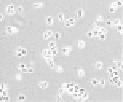Biomedical Engineering Reference
In-Depth Information
Size
Fibroblast 100%
F_s F_n F_o
Fibroblast
specific
morphology
N_s
N_l
Common
morphology
(Noise)
Keratinocyte 100%
K_c K_o K_s K_n
Keratinocyte
specific
morphology
Fig. 8
Object grouping for effective decision tree construction
model for predicting the percentage of contamination of fibroblasts in keratino-
cytes by using only the analysis of objects from the mixed culture images.
From the clustering, nine groups of morphologically different objects found in
the two cell types could be assigned to 9-clusters with high accuracy (Fig.
9
). And
surprisingly, although the nine-cluster model was originally constructed from the
objects in 100% single cell-type images, this model succeeded in predicting
cellular objects in images of co-culture (13 samples with different mixed
percentages ranging from 1 to 30% fibroblast contamination in keratinocytes) with
an accuracy of 93% (±5%). This prediction performance of non-labeling image
cytometry is extremely high, and it should be noted that this cytometry was
performed with non-stained cellular images.
The process of the decision tree modeling, i.e., the clustering with teacher
signals, should provide important insights into the problem of cell classification.
For cell classification, one should realize that cells are swinging between two
phases of different morphologies. One is the characteristic morphology of the cell
type, and the other is the round and small morphology, which is identical between
all the cell types. This round and small morphology may indicate ''cells before
division'' or ''cells beginning to apoptose'' or ''cells in migration.'' With this
common morphology, the classification of ''individual cells'' is extremely difficult.
Because with the case of cells, a certain common population of objects will share
exact same morphologies, and become the noise in the modeling process. The
existence of such a population was very clear when we first attempted to classify
the two cell types by using discrimination analysis (Fig.
10
). Figure
10
shows that
there is an ''indiscriminative'' population within each cell type. We found that
such an ''overlapping'' population can be reduced by defining the ''true-negative
noise objects common to both cell types,'' which is represented by groups 8 and 9
in the above-mentioned criteria (Fig.
9
). However, such noise reduction alone
could not completely improve the prediction accuracy, because of the presence of







Search WWH ::

Custom Search